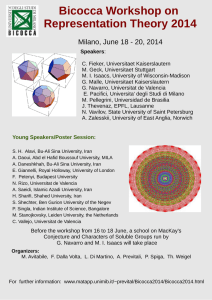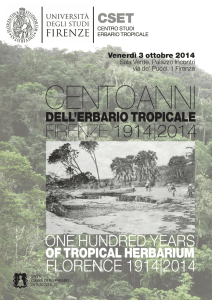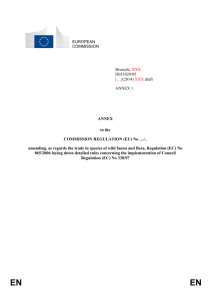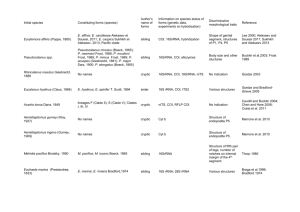Three new species of mygalomorph and filistatid spiders from Iran
advertisement
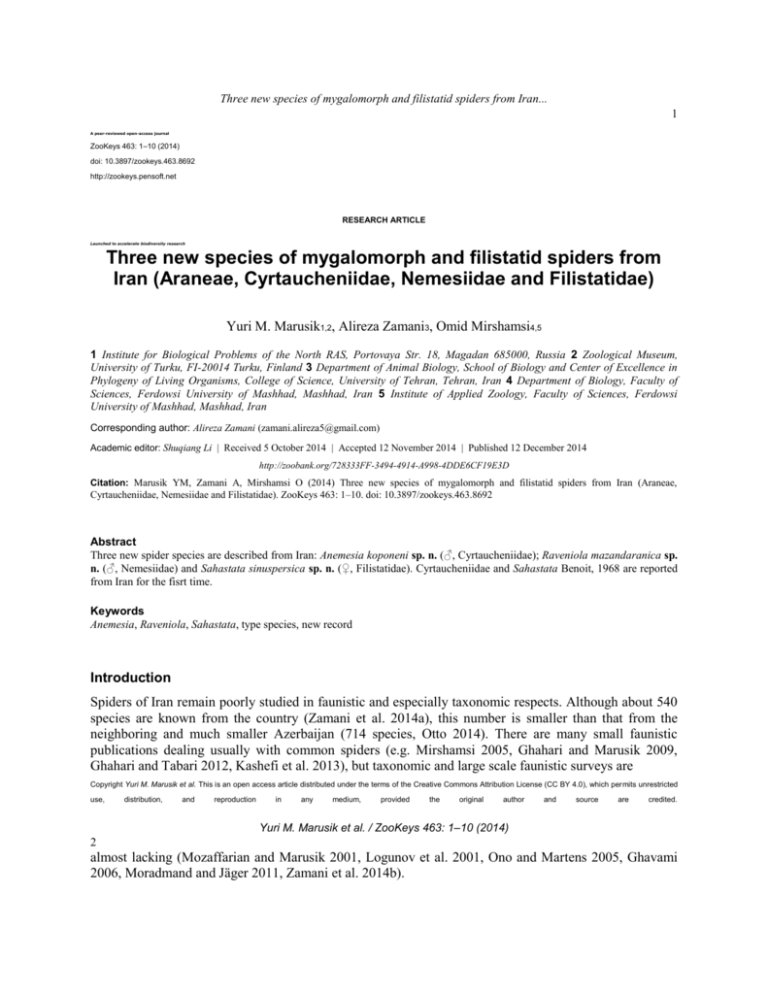
Three new species of mygalomorph and filistatid spiders from Iran... 1 A peer-reviewed open-access journal ZooKeys 463: 1–10 (2014) doi: 10.3897/zookeys.463.8692 http://zookeys.pensoft.net RESEARCH ARTICLE Launched to accelerate biodiversity research Three new species of mygalomorph and filistatid spiders from Iran (Araneae, Cyrtaucheniidae, Nemesiidae and Filistatidae) Yuri M. Marusik1,2, Alireza Zamani3, Omid Mirshamsi4,5 1 Institute for Biological Problems of the North RAS, Portovaya Str. 18, Magadan 685000, Russia 2 Zoological Museum, University of Turku, FI-20014 Turku, Finland 3 Department of Animal Biology, School of Biology and Center of Excellence in Phylogeny of Living Organisms, College of Science, University of Tehran, Tehran, Iran 4 Department of Biology, Faculty of Sciences, Ferdowsi University of Mashhad, Mashhad, Iran 5 Institute of Applied Zoology, Faculty of Sciences, Ferdowsi University of Mashhad, Mashhad, Iran Corresponding author: Alireza Zamani (zamani.alireza5@gmail.com) Academic editor: Shuqiang Li | Received 5 October 2014 | Accepted 12 November 2014 | Published 12 December 2014 http://zoobank.org/728333FF-3494-4914-A998-4DDE6CF19E3D Citation: Marusik YM, Zamani A, Mirshamsi O (2014) Three new species of mygalomorph and filistatid spiders from Iran (Araneae, Cyrtaucheniidae, Nemesiidae and Filistatidae). ZooKeys 463: 1–10. doi: 10.3897/zookeys.463.8692 Abstract Three new spider species are described from Iran: Anemesia koponeni sp. n. (♂, Cyrtaucheniidae); Raveniola mazandaranica sp. n. (♂, Nemesiidae) and Sahastata sinuspersica sp. n. (♀, Filistatidae). Cyrtaucheniidae and Sahastata Benoit, 1968 are reported from Iran for the fisrt time. Keywords Anemesia, Raveniola, Sahastata, type species, new record Introduction Spiders of Iran remain poorly studied in faunistic and especially taxonomic respects. Although about 540 species are known from the country (Zamani et al. 2014a), this number is smaller than that from the neighboring and much smaller Azerbaijan (714 species, Otto 2014). There are many small faunistic publications dealing usually with common spiders (e.g. Mirshamsi 2005, Ghahari and Marusik 2009, Ghahari and Tabari 2012, Kashefi et al. 2013), but taxonomic and large scale faunistic surveys are Copyright Yuri M. Marusik et al. This is an open access article distributed under the terms of the Creative Commons Attribution License (CC BY 4.0), which permits unrestricted use, distribution, and reproduction in any medium, provided the original author and source are credited. Yuri M. Marusik et al. / ZooKeys 463: 1–10 (2014) 2 almost lacking (Mozaffarian and Marusik 2001, Logunov et al. 2001, Ono and Martens 2005, Ghavami 2006, Moradmand and Jäger 2011, Zamani et al. 2014b). While studying spiders of Iran, we found three undescribed species belonging to Mygalomorphae and Filistatidae, two of which represent the first Iranian records of the family Cyrtaucheniidae and the genus Sahastata Benoit, 1968 (Filistatidae). Material and methods Photographs were taken in dishes of different sizes with paraffin at the bottom. Specimens were photographed using an Olympus Camedia E-520 camera attached to an Olympus SZX16 stereomicroscope at the Zoological Museum, University of Turku. Digital images were prepared using “CombineZP” image stacking software. Illustrations of endogynes were made after maceration in 20% potassium hydroxide aqueous solution and exposition for few minutes in alcohol/water solution of Chlorazol Black. Lengths of leg segments were measured on the dorsal side. All measurements are given in mm. Treated materials will be deposited in Senckenberg Museum, Frankfurt am Main (SMF). List of abbreviations is as follows: AME, anterior median eyes; ALE, anterior lateral eyes; PME, posterior median eyes; PLE, posterior lateral eyes; PMS, posterior median spinnerets; PLS, posterior lateral spinnerets. For describing the spination patterns, the following abbreviations or their combinations are used: a, apical; d, dorsal; m, median; p, prolateral; r, retrolateral; v, ventral. Taxonomic survey Cyrtaucheniidae Simon, 1892 Genus Anemesia Pocock, 1895 Comments. Anemesia is a small genus of Cyrtaucheniidae with four species known from Afghanistan, Tajikistan, Turkmenistan and Uzbekistan (Platnick 2014). Species of this genus have been treated in six papers only (Pocock 1895, Spassky 1937, Andreeva 1968, 1976, Charitonov 1969, Zonstein 2001). Anemesia koponeni sp. n. http://zoobank.org/EEDAEB57-B0E0-4CA9-A18F-6FEDF1DF9669 Figs 1–8 Material. Holotype ♂ (SMF) – IRAN: Khorāsān-e Jonoubi Province, Qāen County, Kārizan (33°53'N, 59°49'E), May 1, 2012 (O. Mirshamsi). Three new species of mygalomorph and filistatid spiders from Iran... 3 Etymology. Named after our colleague and friend Seppo Koponen (Turku, Finland), a famous Finnish arachnologist on occasion of his 70th birthday; noun. Diagnosis. The new species has a rather short embolus like in A. birulai (Spassky, 1937) (cf. Spassky 1937, fig. 2). Other congeners occurring in Central Asia have distinctly longer emboli, for example A. karatauvi (Andreeva, 1968) and A. incana Zonstein, 2001 (Figs 9–10). A. koponeni sp. n. differs from the former species by larger body size (15 vs. 10 mm), much darker general coloration (chestnut-brown vs. light yellowish-brown), as well as by longer and spinose palpal tibia (shorter and aspinose in A. birulai). Finally it differs, from the similar A. tubifex (Pocock, 1889) by its narrower eye field with the AME closer to each other (cf. Pocock 1889, fig. 2d). Description. Total length 15.2 including chelicerae. Color in alcohol: carapace, palps and most part of legs reddish-brown; eye tubercle brownish-black; clypeus, chelicerae, femora I–II dorsally dark reddish-brown; sternum, labium, maxillae, palps and legs ventrally yellowish-brown; abdomen dorsally with an indistinct pattern consisting of a short median stripe and a few pairs of interrupted transverse fasciae; metatarsi III-IV, tarsi I-IV, ventral abdominal surface and spinnerets light yellowish-brown. Carapace 6.0 long, 5.2 wide. Eye sizes and interspaces: AME 0.17, ALE 0.25, PLE 0.20, PME 0.12, AME– AME 0.20. Cheliceral rastellum weak. Maxillae with about 15 small cuspules each. Sternum 3.15 long, 2.50 wide. Spination. Palp: femur 3d, 2pd; patella 1p; tibia 2v; tarsus 10d. Leg I: femur 4d, 3pd, 3rd; patella 2p; tibia 3p, 3r, 6-8v; metatarsus 1d, 1p, 1r, 5v. Leg II: femur 4d, 3pd, 3rd; patella 2p; tibia 3p, 2r, 9v; metatarsus 2d, 3p, 1r, 7v. Leg III: femur 3d, 3pd, 3rd; patella 2p, 1r; tibia 1d, 3p, 3r, 6v; metatarsus 3p, 4r, 7v; tarsus 2v. Leg IV: femur 3d, 3pd, 3rd; tibia 1d, 1p, 3r, 6v; metatarsus 1d, 2p, 5r, 7v; tarsus 2v. Patella IV and tarsi I–II aspinose. Scopula: distal on metatarsi I–II, present on tarsi I-III, absent on tarsus IV. Paired claws: inner and outer margins with 6–7 teeth each. Spinnerets: PMS 0.53 long; PLS 2.25 long; apical segment triangle. Palp as in Figs 5–8, thin, femur slightly longer than tibia, and as long as patella; bulb as long as patella, bulb (with embolus) 2.3 longer than widest diameter of bulb; embolus without distinct base, its length subequal to length of bulb. Distribution. The species is known only from the type locality. It is the southwesternmost record of the genus. Nemesiidae Simon, 1889 Genus Raveniola Zonstein, 1987 Comments. Raveniola is a relatively large genus of nemesiid spiders with 22 described species. The genus is distributed from Turkey to China (cf. Platnick 2014). Two species of this genus are known from Iran: R. niedermeyeri (Brignoli, 1972) and R. vonwicki Zonstein, 2000. Both species are well studied by Zonstein (2000) and Zonstein and Marusik (2010). Yuri M. Marusik et al. / ZooKeys 463: 1–10 (2014) 4 Figures 1–11. Habitus and male palp of four Anemesia species: A. koponeni sp. n. (1–8), A. incana (9, after Zonstein 2001), A. karatauvi (10, after Andreeva 1976) and A. birulai (11, after Spassky 1937, modified). 1 male habitus, dorsal 2 eye group and chelicerae, dorsal 3–4 prosoma, dorsal and ventral 5 whole palp, retrolateral 6–8 tip of palp, prolateral, retrolateral and prolateral-apical 9 palp, ventral 10–11 palp, prolateral. Three new species of mygalomorph and filistatid spiders from Iran... 5 Raveniola mazandaranica sp. n. http://zoobank.org/A43C76C0-5750-4B2C-9616-F747BA48DA06 Figs 12–18 Material. Holotype ♂ (SMF), IRAN, Māzandarān Province, Abbās Abād, Salmān Shahr, around Dāniāl Cave (36°39'N, 51°10'E), April 2014 (P. Beyhaghi). Etymology. The specific epithet is derived from the type locality; adjective. Diagnosis. So far, only two Raveniola species are known to occur in Northern Iran: R. niedermeyeri and R. vonwicki. The new species can be distinguished from R. niedermeyeri by its twisted embolus (gradually bent in R. niedermeyeri, Fig. 21). Raveniola mazandaranica sp. n. differs from the similar R. vonwicki by the shape of its embolic tip and by having a tibial prolateral apical spine (arrowed on Fig. 15), lacking in sibling species. All three Iranian species differ in the number of their prolateral apical tibial spines: none in R. vonwicki, two in R. niedermeyeri, and one in R. mazandaranica sp. n. Description. Total length 11.3 with chelicerae and 9.7 without chelicerae. Carapace 5.25 long, 4.9 wide; sternum 2.55 long, 1.85 wide; eyefield 1.13 wide, 0.55 long. Habitus and pattern as in Figs 12–13. Eye sizes and interspaces: AME 0.15, ALE 0.3, PLE 0.2, PME 0.17, AME–AME 0.12. Maxillae with about 10 cuspules each. Palp: 2.75 + 1.55 + 2.25 + 0.9, bulb (including embolus) 0.83 long. Leg I: 4.0 + 2.3 + 3.35 + 3.25 + 1.8. Leg II: 3.85 + 2.0 + 2.75 + 2.75 + 1.8. Leg III: 3.37 + 1.7 + 3.25 + 3.3 + 1.75. Leg IV: 4.2 + 2.0 + 3.35 + 4.75 + 2.0. Metatarsus I modified, with thinner proximal half and thicker distal half (Fig. 14). Spination of palp: femur 2d, 1pa; patella 0; tibia 2d, 1ra, 3p, 3vp, 2vr, 1vm; cymbium 4. Leg I: femur d4, p21; tibia p2, v6. Leg II: femur d4, p3; patella p1; tibia p3, v7; metatarsus p1, v6. Leg III: femur d4, p3, r2; patella p1, r1; tibia d2, p3, r3, v7; metatarsus d2, p3, r3, v8. Leg IV: femur d4, p3, r2; patella p2, r1; tibia d2, p4, r4, v7; metatarsus d5, p4, r4, v10. Scopula: present on metatarsi I–II and tarsi I–II; absent on tarsi III–IV. Paired claws: inner and outer margins with 7–11 teeth each. Spinnerets: PMS 0.3 long; PLS 1.2 long, apical segment triangle. Palp as in Figs 15–17, femur slightly longer than tibia and about 1.5 thicker; patella longer than cymbium and wider than tibia; tibia prolaterally with one apical spine; bulb 2.7 shorter than tibia, embolus bent 3 times. Distribution. The new species is known only from the type locality. Filistatidae Simon, 1864 Sahastata Benoit, 1968 Comments. Sahastata is a small genus of Filistatinae spiders with three described species. It is known from the Mediterranean to India (Platnick 2014). Members of this genus differ distinctly from Filistata by their very hairy sternum+labium and a calamistrum having 2–3 rows of inclined hairs. Yuri M. Marusik et al. / ZooKeys 463: 1–10 (2014) 6 Figures 12–21. Habitus and male palp of three Raveniola species: R. mazandaranica sp. n. (12–18), R. vonwicki (19–20, after Zonstein 2000) and R. niedermeyeri (21). 12 male habitus, dorsal 13 prosoma, ventral 14 leg I, ventral 15, 19 palp, prolateral 16, 20 palp, ventral 17 whole palp, retrolateral 18 spinnerets, ventral 21 bulb, ventral. Three new species of mygalomorph and filistatid spiders from Iran... 7 Figures 22–33. Habitus and somatic characters of two Sahastata species: S. sinuspersica sp. n. (22–29) and S. nigra (30–33). 22, 30 habitus, lateral 23 eye group, dorsal 24, 32 prosoma, ventral 25 spinnerets and cribellum, ventral 26–29, 32–33 calamistrum. Yuri M. Marusik et al. / ZooKeys 463: 1–10 (2014) 8 Figures 34–41. Vulvae of two Sahastata species: S. sinuspersica sp. n. (34–40) and S. nigra (41, after Benoit 1968). 34, 39– 40 dorsal 35 subapical 36 caudal 37 receptacle, subapical 38, 41 dorsal. Three new species of mygalomorph and filistatid spiders from Iran... 9 Sahastata sinuspersica sp. n. http://zoobank.org/DE576BD3-D04B-486D-92C2-653FACA564EF Figs 22–29, 34–40 Material. Holotype ♀ (SMF), IRAN, Hormozgān Province, Bandar-e‘Abbās (found under a large rock, in a sandy substrate near the harbor), 27°11'N, 56°17'E, January 2014 (A. Zamani). Paratypes: 1♀ and 3 juv (SMF), IRAN, Hormozgān Province, Hormuz Island (found under a large rock, in a sandy substrate near the sea), 27°04'N, 56°28'E, January 2014 (A. Zamani). Comparative material. Syntype ♀ of S. nigra (Simon, 1897) from Muscat, in Muséum National d’Histoire Naturelle, Paris. Etymology. The specific epithet is derived from the Persian Gulf (Sinus Persicus in Latin); adjective. Diagnosis. The new species differs distinctly from the type species, S. nigra by its lighter coloration and undivided receptacles (with two heads in S. nigra, Fig. 41). It differs from S. sabaea Brignoli, 1982 by its receptacles which are twice as large in size (6.1 in S. sabaea) and unbranched (with two “heads” in S. sabaea, f. 18, Brignoli 1982). Description. Total length 12.0. Carapace 5.0 long, 4.0 wide; sternum 2.5 long, 2.25 wide. Habitus and pattern as in Figs 22–24. Palp: 2.75 + 1.45 + 1.65 + 1.6. Femur I 5.25 (other segments missing). Leg II: 4.2 + 1.7 + 3.25 + 3.35 + 1.6. Cribellar plates elongate, much longer than high (Fig. 25), calamistrum with three rows of hairs (Figs 26–29). Vulva as in Figs 34–40; receptacles with one distinct head standing on a membranous and goffered stalk; in apical view the receptacle appears to have two heads; head covered with isolated patches of glands; receptacles separated by about 3 diameters. Distribution. The new species is known only from the type locality in Bandar Abbas and Hormuz Island. Acknowledgements We would like to thank Sergei L. Zonstein for consultations and discussion about relationships of the three species described in this paper. Special thanks to Seppo Koponen (University of Turku) for providing museum facilities. The authors are thankful to Parham Beyhaghi, Fatemeh Abedi and Abbas Kazemi for field assistance. English of the earlier draft was kindly checked by Don Buckle. This study was supported in part by the Russian Foundation for Basic Research (grant № 12–04–01548). References Andreeva EM (1968) Materialy po faune paukov Tadzikistana. III. Mygalomorphae. Doklady Akademii Nauk Tadzhikistan SSR 11: 68–71. [In Russian] Andreeva EM (1976) Pauki Tadzhikistana. Dushanbe, 196 pp. [In Russian] Yuri M. Marusik et al. / ZooKeys 463: 1–10 (2014) 10 Benoit PLG (1968) Synopsis des Filistatidae africains (Araneae). Annali del Museo Civico di Storia Naturale Giacomo Doria 77: 92–102. Brignoli PM (1982) Contribution à la connaissance des Filistatidae paléarctiques (Araneae). Revue Arachnologique 4: 65–75. Charitonov DE (1969) Material’y k faune paukov SSSR. Uchenyye Zapiski Permskogo Universiteta imeni A.M. Gorkogo 179: 59–133. [In Russian] Ghahari H, Marusik YM (2009) New data on spider fauna of Iran (Araneae). Turkish Journal of Arachnology 2: 1– 8. Ghahari H, Tabari M (2012) Fauna and population fluctuations of spiders (Arthropoda: Araneae) in rice fields of Mazandaran Province. Journal of Plant Protection 26 (2): 136–144. Ghavami S (2006) Renew checklist of spiders (Aranei) of Iran. Pakistan Journal of Biological Sciences 9 (10): 1839–1851. doi: 10.3923/pjbs.2006.1839.1851 Kashefi R, Ghassemzadeh F, Kami HG, Mirshamsi O (2013) New data on spider fauna from Golestan province, Iran (Arachnida, Araneae). Progress in Biological Sciences 3(1): 7–22. Logunov DV, Marusik YM, Mozaffarian F (2001) Faunistic review of the jumping spiders of Iran (Aranei: Salticidae). Arthropoda Selecta 10: 155–167. Mirshamsi O (2005) Faunistic study of spiders in Khorasan Province, Iran (Arachnida: Araneae). Iranian Journal of Animal Biosystematics 1(1): 59–66. Moradmand M, Jäger P (2011) A review on the huntsman spider genus Spariolenus Simon, 1880 (Araneae: Sparassidae: Heteropodinae) in Iran with description of four new species. Zootaxa 2910: 46–62. Mozaffarian F, Marusik YM (2001) A checklist of Iranian spiders (Aranei). Arthropoda Selecta 10(1): 67–74. Ono H, Martens J (2005) Crab spiders of the families Thomisidae and Philodromidae (Arachnida: Araneae) from Iran. Acta Arachnologica 53: 109–124. doi: 10.2476/asjaa.53.109 Otto S (2014) Caucasian Spiders: a faunistic database on the spiders of the Caucasus. Version 1.4. http://caucasusspiders.info/ Pocock RI (1895) Descriptions of new genera and species of trap-door spiders belonging to the group Trionychi. Annals and Magazine of Natural History (6) 16: 187–197. doi: 10.1080/00222939508680252 Spassky SA (1937) Araneae palaearcticae novae. Mygalomorphae. I. Festschrift Embrik Strand 3: 361–368. Zamani A, Mirshamsi O, Marusik YM (2014a) The checklist of the spiders of Iran. http://www.spiders.ir/ [Version 2014] Zamani A, Nikmagham Z, Allahdadi M, Ghassemzadeh F, Mirshamsi O (2014b) New data on the spider fauna of Iran (Arachnida: Araneae). Zoology in the Middle East 60(4): 362–367. doi: 10.1080/09397140.2014.970383 Zonstein SL (2000) Two new species of the mygalomorph spider genus Raveniola Zonstein, 1987 (Araneae, Nemesiidae) from southwestern Asia. Tethys Entomological Research 2: 49–52. Zonstein SL (2001) Notes on allocation of the mygalomorph spider genus Anemesia Pocock, 1895 (Araneae), with description of a new congener from Tajikistan. Tethys Entomological Research 3: 11–14. Zonstein SL, Marusik YM (2010) Raveniola niedermeyeri from Iran: redescription and new data on distribution (Araneae, Nemesiidae). ZooKeys 57: 51–57. doi: 10.3897/zookeys.57.497
